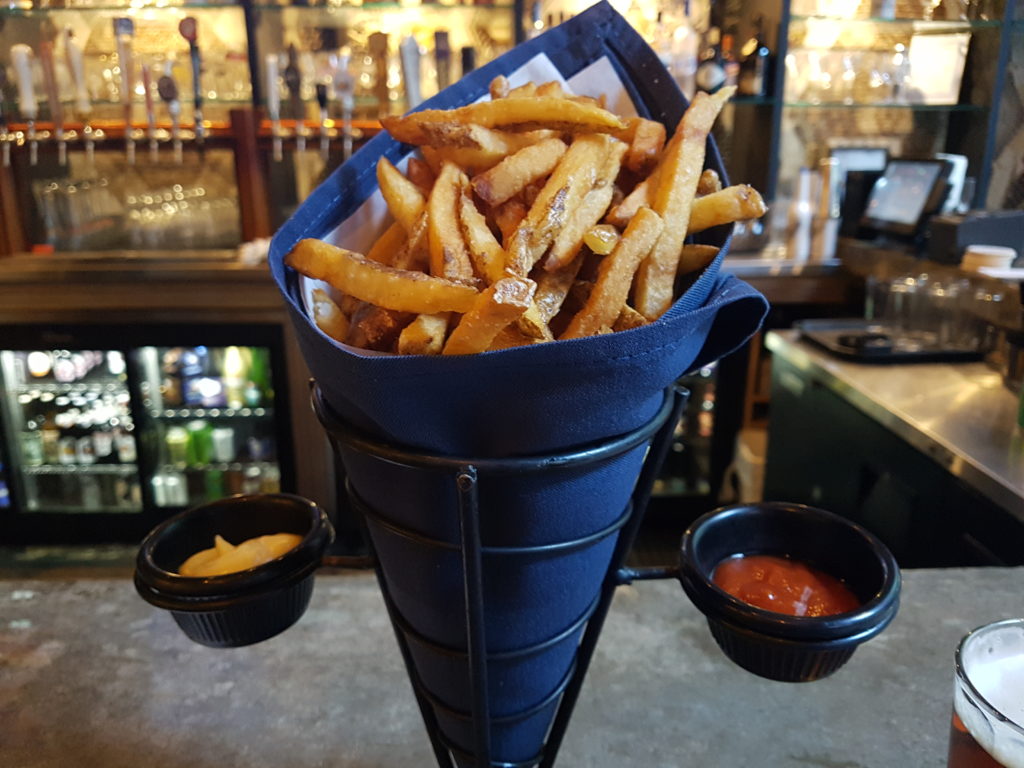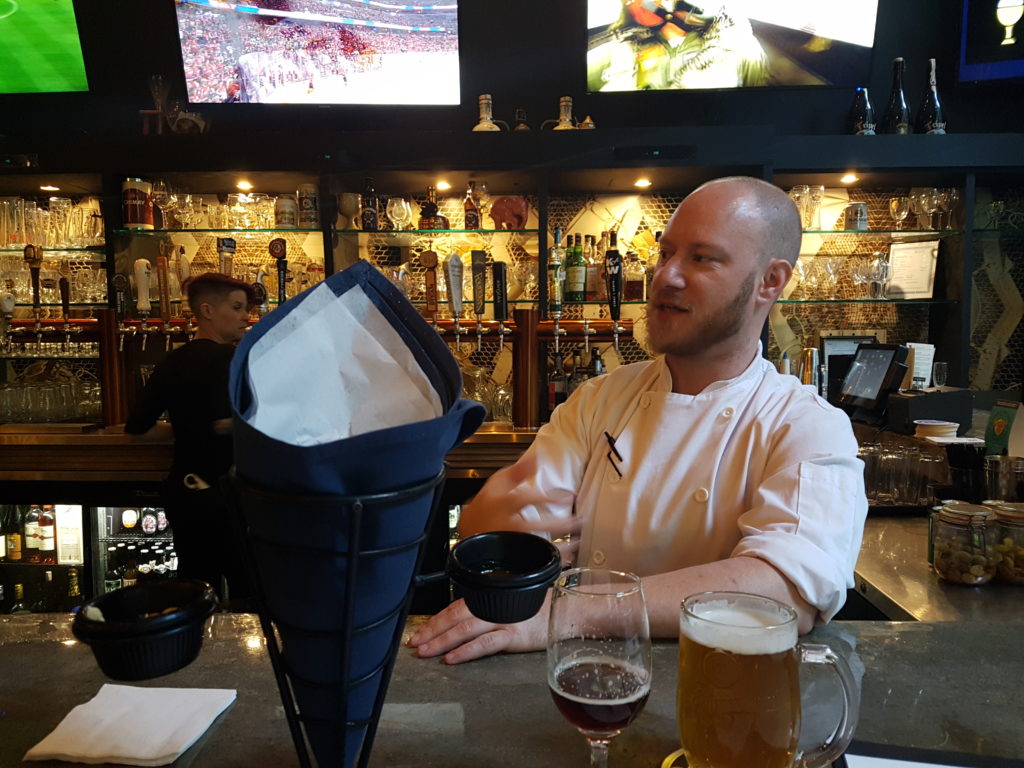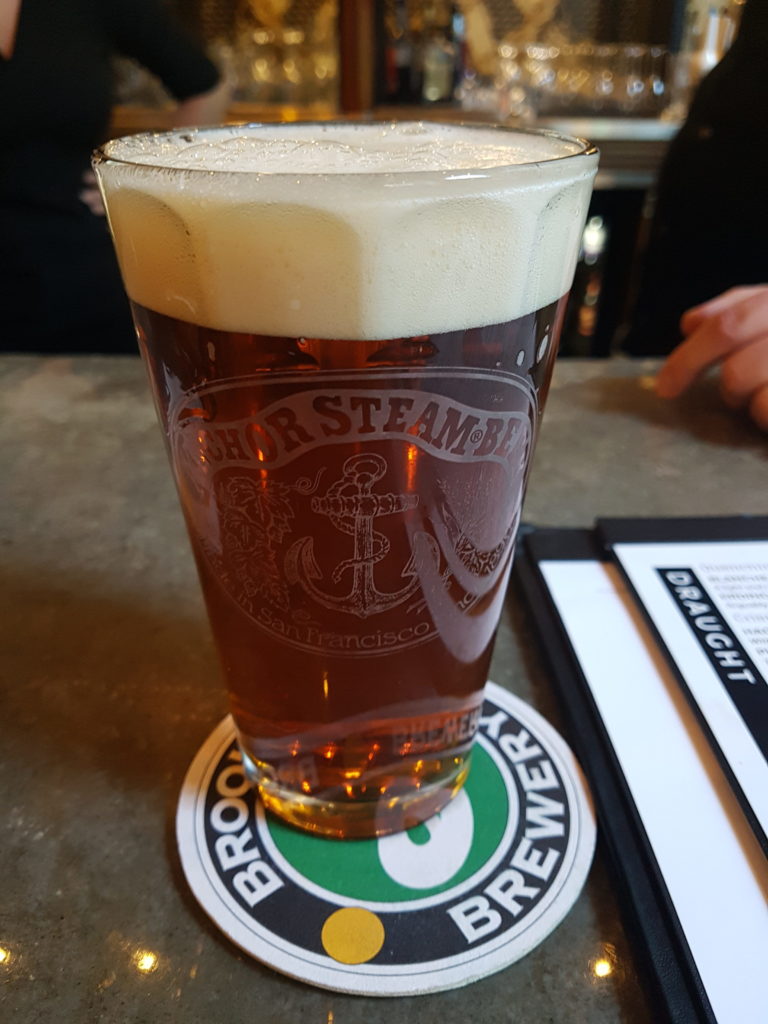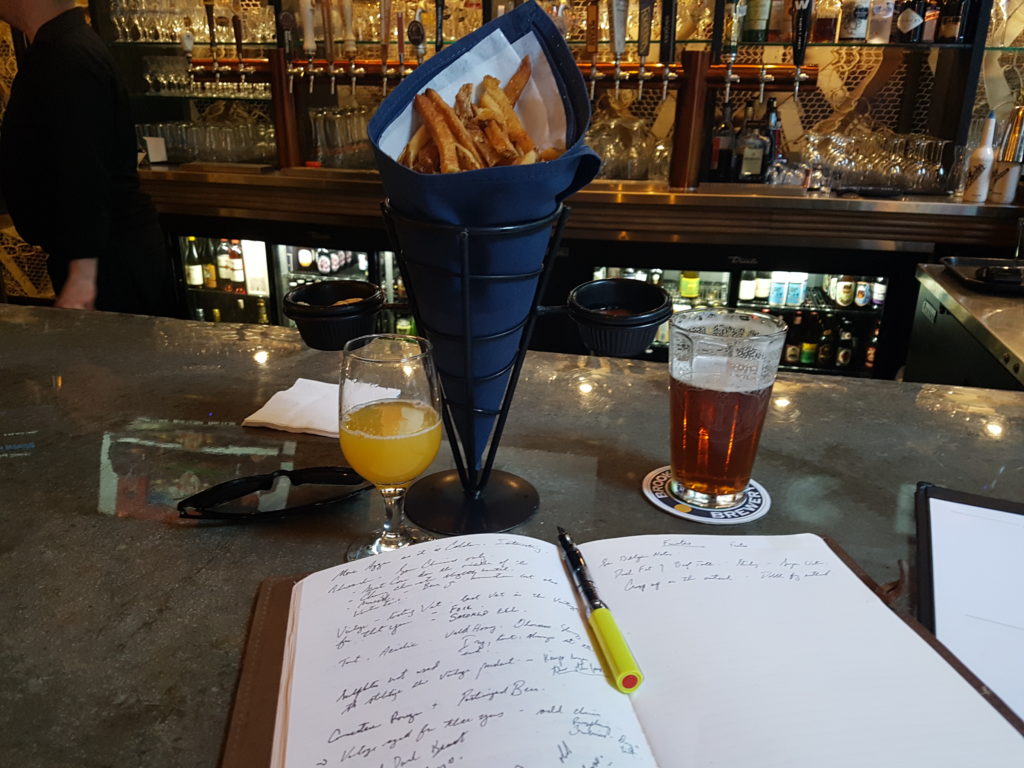Gregg Irwin from Fourpure says, as we’re enjoying the collaborative Pilsner they’ve brewed with Henderson for the launch of a beer that didn’t quite clear customs, that the thing that got him into beer was beerbistro. It was around 2008 and it was the first time he had Dogfish Head. This was back when Dogfish was in Ontario. I remember having the World Wide Stout at about the same time in the same bar. The difference is I didn’t go to England and start a brewing company.
He went back to beerbistro this year and although the selection of beers has changed, he recognized the space. It’s hard not to. Although the decor has been tweaked, some things don’t changed; the airy reverberating ceiling in the room and the roughly Belgian shape of the concept. Greg, behind the bar, still balances glassware precariously on his head.
Brian Morin and Stephen Beaumont did yeoman work in putting the idea together. The beer pairing system on the menu works with very approachable descriptors like “crisp” or “bold” or “sociable.” At this point, that might seem a little quaint, but it’s a useful shorthand for the uninitiated and is at least a starting point. Most places don’t get that far.
If there’s one iconic menu item at beerbistro, it’s the frites. They arrive at the table in a sleeve of paper inside a napkin supported by a wire frame that holds two ramekins; one of house smoked ketchup and one of house made mayonnaise. There is some difference over time. The napkins are now blue.
I’m thinking about beer and food from the ground up, and I have a tendency to research fairly heavily. Bear with me.
Larousse Gastronomique (at least my 1977 translation) claims that frites are a French invention. Of course it does. Larousse Gastronomique couldn’t be more French if it painted in a garret apartment while eating tinned escargot. What is certain is that by the mid 19th century, people throughout France and Belgium were eating frites in some quantity. This is not surprising, given the dietary circumstances of the era.
We think of frites as decadent. They might be in a modern context. Consider Europe in the early 19th century. You’ve suddenly got improved agricultural practice and industrialization. Walter Raleigh introduces potatoes to Ireland in 1589 and forty years later, they’re everywhere. They’re hardy (except when there’s blight) and contain vitamin c (so your teeth don’t fall out.) They have a lot of calories: 77 per 100 grams. They develop an earthy, lightly bitter character due to pyrazine in the soil and in the plant. One wonders where Western Europe would have been without new world crops. Almost certainly less populous over time.
The thing is this: It’s pretty hard to improve upon potatoes as an agricultural product. At a time when animals are being bred leaner for more protein and other plants are beginning to undergo unnatural selection, the potato remains more or less untouched. Harold McGee’s On Food and Cooking suggests the Irish were eating 5-10 pounds per man per day in 1845. Peter Schollier’s book Food Culture in Belgium says the Belgians were at something like 2.25 pounds per man per day in 1850. They would fry them in beef tallow to add calories because food was so expensive. They ate them with mussels because mussels were cheap.
It turns out that a lot of what you’d think of as traditionally beer friendly food is borne out of privation. And yet, on weekdays you’ve got Bay Street bankers ordering them. Talking to Nathan, who is now the chef at beerbistro, we theorize a little about it. It is more or less the gentrification of peasant food. He gives the example of bouillabaisse; originally a dish made up of the leftover catch that no one would purchase, two of the first three recipes I can find online include lobster and saffron. Haute cuisine or not, they go through 200 pounds of potatoes a day.
Cooking frites properly is complex. It’s time consuming. In the case of the beerbistro, the frites are cooked three times. The first is at a fairly low temperature in a mixture of beef tallow and duck fat. This is designed to break down the cellular walls on the outside of each chip and remove some liquid from the center of the potato. The second and third trips to the fryer use canola oil. At one point, this was peanut oil, but canola is slightly more cost effective. The second dip in the fryer firms up the outside of the chip, taking advantage of the weakened cellular walls to create a crispy barrier. The third dip finishes the cooking for service, creating a chip with a crisp outside and a soft center. Naturally, they’re dressed with salt.
Now, the technique is different than the peanuts I was enjoying the other week, but a lot of the flavours come from the same places. Deep frying creates the non-enzymatic browning that roasting also creates and you’ve still got pyrazines in the potatoes developing that melanoidin character during the cooking process. It’s a beer snack, so you need salt. Obviously, the base levels of flavour are different. The duck fat and beef tallow add some umami, and there are other components on the … wire rack. It’s not really a dish.
I’m experimenting, and I’ve never seen Anchor Steam on draught before, so I’m leaning in that direction. It’s a pretty good match in terms of intensity. The deep fried frites match more or less with the caramel malts in the beer. There’s some sugar and there’s some melanoidin. There’s a small amount of bitterness in the frites that are outweighed by the northern brewer hops which are myrcene heavy and earthy; a little dirty spice.
The thing I’ve always liked best about the frites is the house smoked ketchup. Nathan explains that the kitchen smokes onions, tomatoes and garlic and then slow cooks that puree for a couple of hours with some seasoning in order to produce it. It’s slightly jammy in flavour, but there is still acidity and there’s a little more smoke. In combination, it provides a shift in intensity. The frites are still earthy, but there’s sweetness now, and the runniness of the ketchup changes the mechanical process of eating slightly. There’s less fat to lift off the palate.
Grimbergen Dubbel turns out to be a winner. There’s still the mid range caramel and toasted malt, but the hint of dried fruit sweetness complements the ketchup. It’s likely a little more carbonated as well, making the experience a good deal more vibrant than the Anchor Steam.
What about the mayonnaise? Well, I feel like the mayonnaise offers you a cheaty out. As it stands, it’s a creamy textured emulsion of fats. You could flavour a mayonnaise with just about anything and customize it to the pairing. As it stands, it works tolerably well with just about anything from a mechanical perspective. Carbonation to lift the fat and reset the palate. From a flavour standpoint, you could doctor it with thyme and lemon juice to make it more complementary to Pilsner Urquell. Hell, you could use citrus zest and mango juice and make dipped frites more amenable to pairing with Collective Arts Liquid Arts Fest. What a Belgian might think of that I couldn’t tell you, but I have suspicions.
What have we learned? We have learned that the frites have improved since Nathan took over the kitchen. The smoked ketchup is back on par with the heyday of the restaurant. We have also learned something that I suspect is going to keep cropping up as I think about beer and food pairing: Much of what we think of as orthodoxy in pairing is derived from poverty and necessity rather than choice. I suspect there is retroactive justification going on as people have gentrified what was peasant food into a middle class fascination. How many episodes of food television have you seen where people instruct you on how to cook the perfect fries at home?
Maybe for the next post, I will eat a salad.




No one turns food science writing into readable journalism better than you Jordan. Now I’m hungry. And i want fries. I mean frites.
I am glad you enjoyed my suggested beer pairing with your frites!